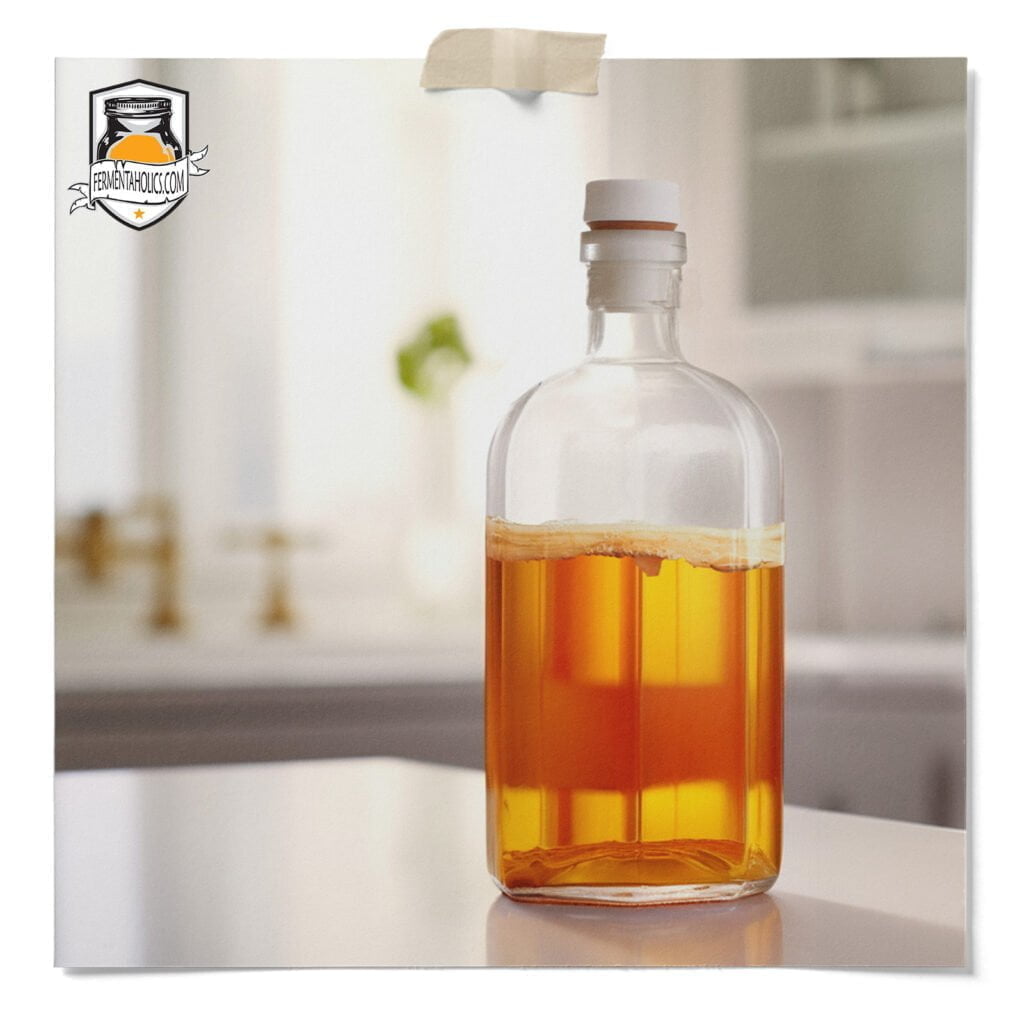
If you have been making kombucha long enough, you will inevitably come across a new SCOBY forming during the secondary fermentation in the bottles. This creates confusion for some, as SCOBY formation is nearly always only discussed as a process in primary fermentation. So when you see a SCOBY in the bottle, it doesn’t go without question. Nonetheless, this is normal; like primary fermentation, bottle conditioning is a continuation of the same process, just a second round, i.e., a secondary fermentation. Simply put, the same fermentation process that takes place in the first round also occurs in the second. Let’s Dive Deeper.

Yes, even in the bottle, the microorganisms in the kombucha culture are still at work at room temperature. Yeast is the primary focus at this stage, as they are the ones who consume the added sugar and create carbonation as they ferment through it. While the yeast is busy making CO2, the SCOBY created in the bottle is simply due to bacteria continuing fermentation in the bottles as well, a secondary fermentation. So, while the formation of a new SCOBY in the bottle is normal and indicates that the microorganisms in kombucha are active, one not forming doesn’t mean the opposite.
The reason for the formation of a new SCOBY in the bottle is often due to the extra head space. For example, if you were to fill your swing top bottles halfway with kombucha, your bottle would now be half liquid and half air. The extra air in the bottle is now available as a resource for the culture to draw from, which will help to promote the formation of a SCOBY.
Now, similar to your primary fermentation, the bottles now have an extra but limited supply of air to work with inside the bottle. With additional air space, the likelihood of SCOBY forming inside the bottle increases.
The best practice to lower the chances of forming SCOBY in kombucha bottles is to fill them up more to keep headspace limited. If you run out of kombucha when bottling, the last bottle will probably end up partially filled, increasing the likelihood of a SCOBY forming.
At the end of the day, this is a non-issue and does not affect the quality, safety, or taste of the kombucha. The only time this would be an issue would be in the unlikely scenario of the SCOBY getting too big inside the bottle and then having trouble getting it out. Just like a ship in a bottle.
The good news is that this wouldn’t happen overnight. This can easily be prevented by keeping an eye on the bottles and removing the SCOBY as needed.
If a SCOBY forms during the second fermentation, you can filter it out when serving, eat it, save it, or toss it. It’s up to you; let’s go over each.
If you notice a new SCOBY in your bottle, you can easily filter it out of your kombucha before drinking. When you are ready to serve, pour the kombucha into a glass through a fine mesh strainer. That’s it; your SCOBY is gone, and your kombucha is ready to drink.
The new SCOBY layer in your bottle is entirely edible and packed with beneficial microorganisms. If you don’t mind the texture, you can eat it. You’d not be alone if eating it straight up doesn’t sound appetizing. There are quite a few ways to cook with or process the SCOBY. Check out our recipe for kombucha fruit leathers; if you’re unfamiliar with fruit leathers, think Fruit Roll Ups™ made with SCOBY and fruit.
Yes, you can keep this SCOBY or add it to a SCOBY hotel, but trying to brew with it alone isn’t very practical.
The formation of a new SCOBY in your bottles during kombucha secondary fermentation is completely normal and mainly due to increased headspace. So don’t worry; it’s a good sign and means that the microorganisms responsible for making your kombucha are active, healthy, and hard at work! So, if you come across this and aren’t sure what to do with it, it’s the kombucha brewers’ choice. You can filter it out before drinking, add it to your SCOBY hotel, or even eat it with your kombucha – tea and a crumpet … if you like.
If you enjoyed this article and found it helpful, be sure to sign up for our newsletter by entering your email address in the footer below.

Yes, with a new SCOBY in the bottle, it is safe to drink kombucha. A SCOBY is edible, so you can choose to filter it out of the kombucha, discard, store, or eat it.
So, yes, you can use the new SCOBY from the bottle to start a new batch of kombucha. But it’s highly unlikely that it will be large enough to start the next batch on its own. I wouldn’t do it for two reasons. Practicality, and because the kombucha you made it from is probably flavored. It’ll probably be small and won’t be enough to do much by itself in terms of batch size. Secondly, most kombucha is flavored in a secondary formation. So, while you can use flavored kombucha to start a new batch, plain is always recommended.
You can keep the extra SCOBYs in a glass jar with some kombucha starter tea or a SCOBY hotel. But if this comes from a flavored kombucha, I’d choose to keep the flavoring out of the hotel. Otherwise, keep the jar covered with a breathable cloth from here and store it like a primary fermentation. The SCOBYs can be stored for extended periods in this manner.
